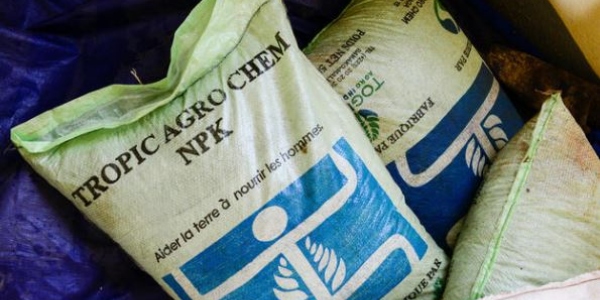People interested in growing bananas would typically want to know the best fertilizers for bananas. Well, depending on soil type, a fertilizer will provide at least one vital nutrient required for the banana plant. There are two main types of fertilizers, inorganic and organic fertilizers gardeners use.
The Ideal Fertilizer For Bananas
The best fertilizer recommended for bananas is well-balanced fertilizer of 8-10-8 (NPK). A well-balanced organic fertilizer with formula 10-10-10 is also an excellent choice.
Fortunately, bananas do not always need fertilizers. They do well in tropical areas where the temperature average is 27 degrees Celsius. The plants also thrive in rich, dark, and fertile soil with a steady supply of moisture and good drainage.
In addition, bananas require a massive investment. The investment is mainly in infrastructure, irrigation, packing facilities, transport technology, and fertilizers.
List of Banana Fertilizers
1. Fertilizer granules or powder
Granules and powder are scattered and worked into the soil followed by sufficient watering. These fertilizers provide nutrients for immediate usage or storage. While powders show results within one week, granules can take up to two weeks to unleash the results.
The choice of granules or powders is based on the requirement of your banana at the moment. Some powders and granules can be used to improve soil fertility. Typically, fertilizer granules and powders are organic. Though not all.
2. Fertilizer spikes
Fertilizer spikes provide sufficient, long-lasting, and consistent vital nutrients. Furthermore, applying the spikes is simple. Insert the spikes into the ground at the base of a banana plant along the drip line. You can use rubber bullets to plug the spikes into the soil anyway.
The spikes will release the nutrients according to the requirement of the banana plant for eight weeks.
Although fertilizer spikes are very convenient to deal with, they have their back drawing. Spikes are more expensive to administer to plants compared to other fertilizers. Besides, a banana plant needs more than one spike to mature.
3. Coffee grounds
The best natural fertilizers for bananas is the coffee grounds. Coffee grounds are a great source of nitrogen for banana plants. Using this natural method is simple, add the grounds directly into the soil and spread them evenly at the base of the bananas. Do not forget to water your banana tree regularly.
Coffee grounds are inexpensive fertilizers that will make your banana bunches produce many tasty banana fingers. So, you can enjoy your coffee and still feed your bananas. It sounds like a good deal because it is cost-friendly.
4. Miracle-Gro.
Miracle-Gro produces some water-soluble, and granular formulae of synthetic fertilizers. Applying Miracle-Gro fertilizer enable your bananas to flourish and produce a good quality and quantity of bananas.
However, this fertilizer contains a high ratio of nitrogen, phosphorus, and potassium. Being careful while reading instructions is necessary to avoid over-feeding bananas with fertilizers. Miracle-Gro’s all-purpose food plant fertilizer has the formula 24-8-16 (NPK) and can be used for various types of plants.
5. Hi-yield garden fertilizer.
This fertilizer not only has the right combination of 8-8-8 (NPK), but it can also be used to feed other plants such as vegetables, flowers, and trees.
6. Schultz plant food
The water-soluble formula for Schultz is 10-15-10 (NPK). It has a strong dose of nitrogen and potassium for banana trees. Instructions provided for dilution of the fertilizer should strictly be adhered to.
How to Apply Banana Fertilizers
Fertilizers can work effectively and efficiently when they have applied appropriately. Otherwise, an unwise application could lead to the wastage of the fertilizer or destruction of banana plants. Several factors should be considered when applying fertilizers. The factors include; source, rate, time, and place.
Drilling.
Drilling is a method of fertilizer application that is employed during planting. In this method, a fertilizer is placed at a lower depth just below the roots of a young banana plant. Ensure the fertilizers are not beyond the reach of the banana roots.
Broadcasting.
The broadcasting method involves scattering fertilizer powders at the base of a banana plant. This method is the easiest and even. But, broadcasting is not suitable for volatile fertilizers. Volatile fertilizers may melt and evaporate before they are absorbed by the bananas when exposed to heat from the sun.
Side dressing.
Side dressing means applying fertilizers along the side of banana plants. This method is used once the banana plant has started growing.
Ringing.
In this method, fertilizers are applied in a circular line around the base of a young banana plant.
Spraying.
The spraying method is best applicable when dealing with liquid fertilizers. Soluble fertilizers can also be dissolved in water as directed by instructions and put in a sprayer tank. Using a sprayer tank, a controlled amount of fertilizers can be sprayed directly onto the banana leaves to be absorbed.
The spraying method should not be used when the weather is windy as it can lead to losing wastage.
Why Apply Fertilizers?
Fertilizers provide plants with essential nutrients such as nitrogen, potassium, and phosphorus. These nutrients enable banana plants to grow fast, bigger, and produce more fruits.
When to apply fertilizers?
The best time to apply fertilizers to a banana plant is not specific. Bananas need essential throughout their lifetime to thrive well. It is recommended to apply fertilizers every month to enable a sufficient supply of nutrients to the banana plant.
Fertile soils which have enough nutrients do not require fertilizers. Excess amounts of certain nutrients may cause disorders and ruin your expectation as a banana farmer.

